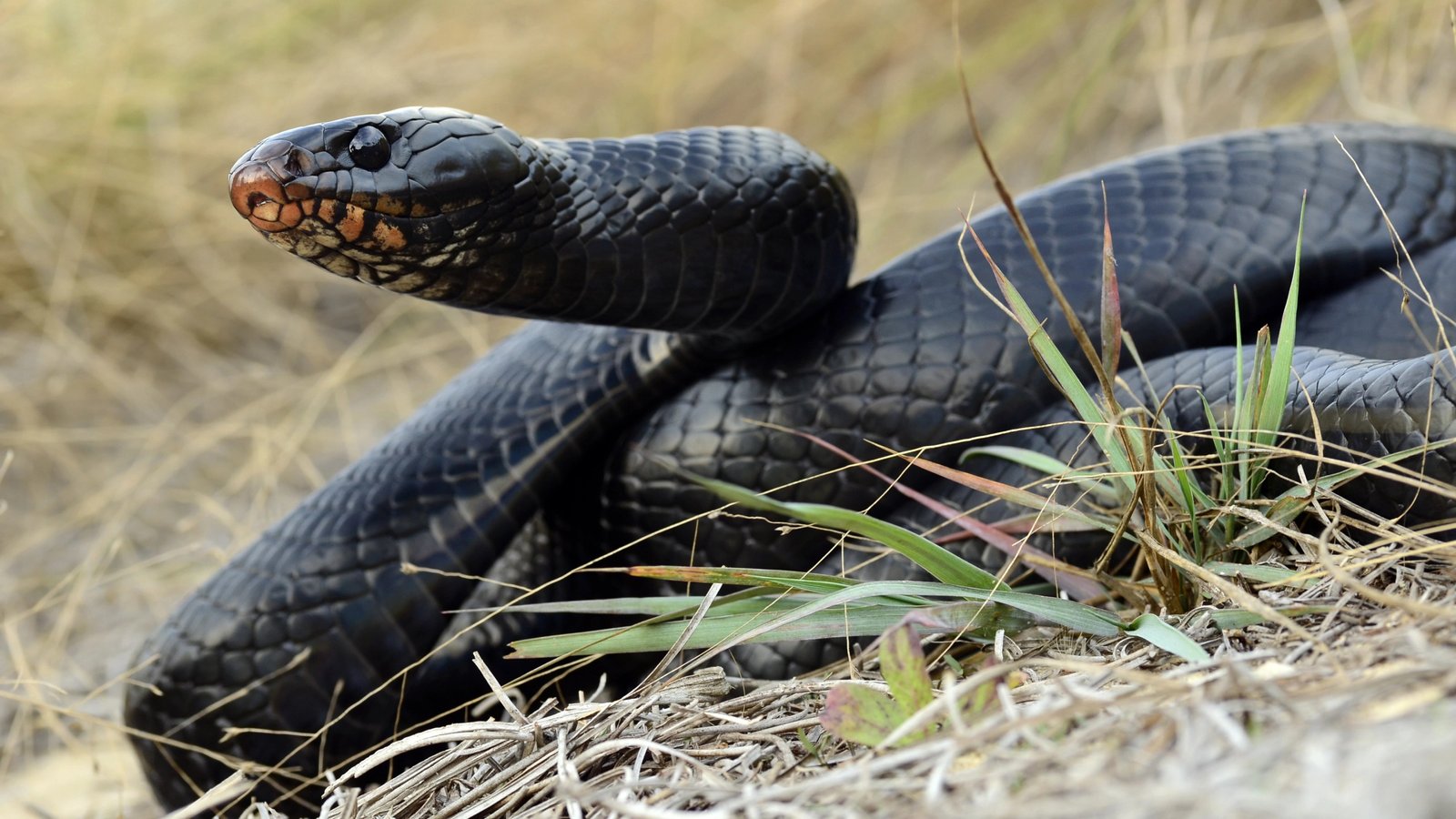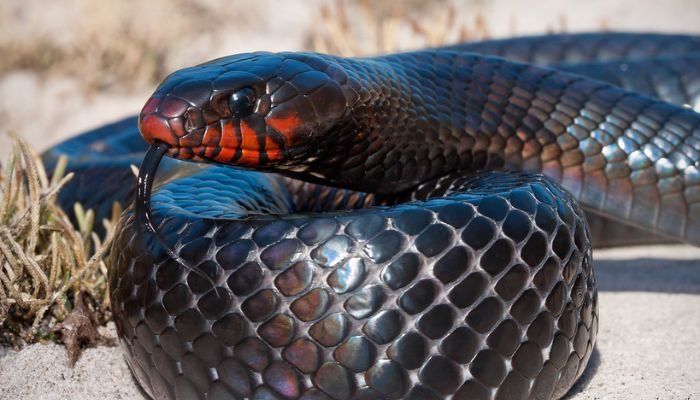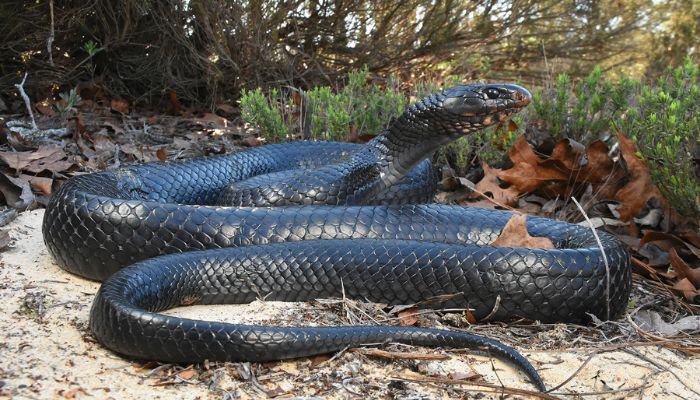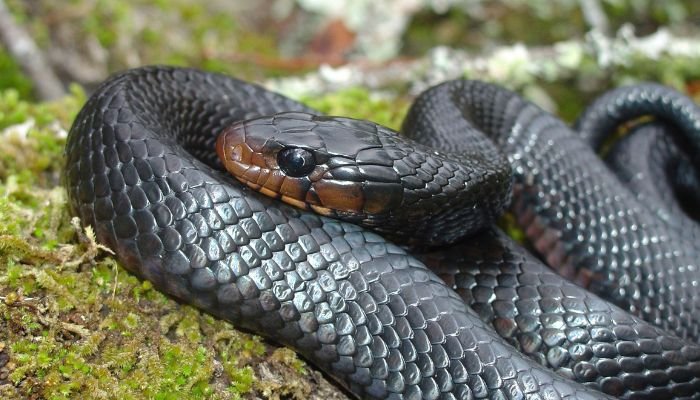
The Indigo Snake is one of the longest species of serpent in North America and is distinguished by its glossy, blue-black coloring. Due to their exceptional adaptability, indigo snakes are located in a variety of habitats, including pine forests, marshes, and prairies. Small mammals, birds, and reptiles make up the majority of their diet. Regrettably, habitat degradation and persecution have led to a decline in their population, which necessitates the implementation of conservation measures.. Here are Indigo snake Guide on Food, Habitat, Size, Lifespan & Predators below-
Indigo Snake Stats in Table format
The stats are given below for Indigo snake
| Reptiles List | Indigo snake |
|---|---|
| Family | Colubridae |
| Type | Snake |
| Size | Large |
| Length | Indigo snake: Up to 6-8 feet (1.8-2.4 meters) |
| Color | Indigo snake: Usually has a shiny blue-black coloration. |
| Weight | Indigo snake: Can weigh between 4 to 10 pounds.. |
| Lifespan | 10-15 years (or more) |
| Reproduction | Oviparous, lays eggs |
| Gestation Periods | Approximately 3-4 months |
| Endangered Status | Least Concern (IUCN Red List) |
| Features | Glossy bluish-black coloration, non-venomous |
| Country & Areas | United States, Mexico, Central America, South America |
Indigo Snake Natural Habitat and Distribution
A common sight in the southeastern United States and northern Mexico, the indigo snake has a vast range. It stretches from southeastern Texas and northeastern Mexico down through southern Georgia and Florida. Some islands in the Caribbean and Gulf of Mexico also have it. The indigo snake is most at home in dry, sandy areas with plenty of cover and proximity to water. Pine flatwoods, sandhills, scrublands, hardwood hammocks, swamps, marshes, river floodplains, agricultural fields, and urban settings are all places you could stumble upon it. The indigo snake is a remarkably resilient reptile, able to endure a wide variety of stresses.
Indigo Snake Physical Features and Adaptations
Here are som information about Indigo Snake Physical Features and Adaptations
1. Body Structure
The indigo snake can grow up to 2.6 meters (8.5 feet) in length, making it one of the longest snakes in North America. Its body is thick and covered in smooth scales, and its head is big and spherical. The indigo snake’s jaw is so strong that it can crack turtle and egg shells. It can balance and move with the aid of its long tail.
2. Coloration and Patterns
The indigo snake’s entire body, including its belly and chin, is a consistent glossy dark blue-black color. Some people have slight tinges of red or brown on their sides or necks. The indigo snake’s coloring aids in both camouflage and temperature regulation in its natural environment.

3. Defense Mechanisms
The indigo snake is a non-venomous reptile that uses its large size, powerful body, and rapid speed to evade or scare away potential threats. The indigo snake’s defensive mechanisms include a loud hiss, swelling of the body, coiling up, and an open mouth for striking. It can also use a putrid scent released from its cloaca to ward off predators. The indigo snake has been observed eating other snakes, including deadly ones like rattlesnakes and cottonmouths.
Indigo Snake Diet and Feeding Habits
Here are som information about Indigo Snake Diet and Feeding Habits:-
1. Diet Type
The indigo snake is a carnivorous reptile that consumes mammals, birds, reptiles, amphibians, fish, reptile eggs, and even other snakes. It’s a scavenger, so it’ll consume whatever it can get its hands on. It hunts by smelling and seeing its target, which it then grapples to the ground with its muscular jaws.
2. Preferred Food Sources
The indigo snake’s diet is determined by the variety and number of prey in its natural environment. The indigo snake typically feeds on rodents, squirrels, rabbits, and other small animals, as well as reptiles including lizards, turtles, and other snakes. In the event that birds, eggs, frogs, or fish are readily accessible, it may eat them instead.
3. Feeding Schedule
Season, temperature, and the availability of prey all affect the indigo snake’s feeding habits. The indigo snake, like other snakes, prefers warmer weather when feeding, and colder weather when feeding less frequently. In the winter or just before shedding its skin, it may go without food for weeks or even months. The indigo snake is primarily a daytime hunter, though it has been observed at night and at dawn and dusk.
Indigo Snake Housing and Enclosure Requirements
Here are som information about Indigo Snake Housing and Enclosure Requirements:-

1. Terrarium Size and Setup
The indigo snake’s size and activity level necessitate a roomy and expansive terrarium. An adult indigo snake should measure at least 1.8 x 0.9 x 0.9 meters (6 x 3 x 3 feet), but the larger the better. The terrarium’s lid should be locked in place to prevent escape and should contain openings for air circulation. The ideal temperature range for the terrarium is between 24 and 32 degrees Celsius (75 and 90 degrees Fahrenheit), with a basking spot around 35 degrees Celsius (95 degrees Fahrenheit). A thermometer can be used to keep track of the temperature when a ceramic heat emitter, heat mat, or heat lamp are utilized to generate heat. An ideal photoperiod for a terrarium would be 12 hours of light followed by 12 hours of darkness, as this would closely resemble the natural day/night cycle. You can use a timer in conjunction with a fluorescent tube light or an LED light to regulate the length of the photoperiod.
2. Substrate Options
The indigo snake requires a clean, secure, and comfy substrate. Indigo snakes should be kept on a medium that is similar to the ground, such as sand, soil, peat moss, cypress mulch, or aspen shavings. The indigo snake needs a substrate that is at least 10 cm (4 inches) deep so that it may burrow and hide. Mold, mites, and germs can all be avoided by routinely replacing the substrate.
3. Temperature and Lighting
The indigo snake relies on both a lighting cycle and a temperature gradient to maintain a steady circadian rhythm within its body. The ideal temperature gradient includes a 24 C (75 F) low, a 32 C (90 F) high, and a 35 C (95 F) high basking point. Light and dark should alternate for a total of 24 hours every day. For warmth, you can use a ceramic heat emitter, heat mat, or heat lamp; for light, you can choose between a fluorescent tube light and an LED light. A timer and thermometer can be used to keep an eye on the temperature and adjust the lights accordingly.
4. Humidity and Water Needs
The indigo snake requires a comfortable humidity to keep its skin supple and hydrated. The indigo snake does best with humidity between 50 and 70 percent. The humidity can be determined with the help of a hygrometer. Misting the terrarium with water, adding live plants, a humidifier, or a fogger are all great ways to boost the humidity level. Increasing airflow or cutting back on nearby water sources are two ways to lower the relative humidity. The indigo snake also need a wide, shallow bowl for soaking and drinking. The water dish should be kept in the terrarium’s cooler end, and it should always be filled with clean water. Algae, bacteria, and parasites can all flourish in stagnant water, so it’s important to clean and change the dish frequently.
Indigo Snake Behaviour and Temperament
Here are som information about Indigo Snake Behaviour and Temperament
1. Activity Levels
Diurnal means that the indigo snake is mainly active during the day. The time of day it is most active depends on the weather and the availability of food. The indigo snake is an inquisitive explorer that enjoys venturing both within and outside of its habitat. Depending on its disposition, it may burrow, climb, or bask in its terrarium.
2. Social Behaviour
The indigo snake is an asocial creature that does not like to be with other animals. It may live peacefully with other indigo snakes or similarly sized and temperamental nonvenomous snakes, or it may compete with them, attack them, or even consume them. Because of its potential predation and aggressive tendencies, the indigo snake should not be housed with other animals. The indigo snake’s terrarium should be large enough, with plenty of hiding spots, to prevent aggression and stress.
3. Handling and Taming
The indigo snake is a mild-mannered creature that responds well to human care. Unless provoked or threatened, it almost never bites or constricts. When handling an indigo snake, it’s important to be calm and certain. Handling the indigo snake too often or for too long can give it stress or damage. When the indigo snake is shedding, eating, digesting, or pregnant, it is more sensitive and should not be touched.
Indigo Snake Breeding and Reproduction
Here are som information about Indigo Snake:-
1. Mating and Courtship Rituals
Indigo snakes typically mate in the months of November through April, though this timing can vary greatly depending on latitude and weather. It’s possible that men fight for women by grappling and trying to pin each other to the ground. During the mating season, females may mate with more than one male. To mate, males bring their cloacas together and put one of their hemipenes (paired copulatory organs) into the female’s. During copulation, the male may sometimes bite the female on the head or neck.
2. Incubation and Hatchlings
The indigo snake is an oviparous species. In May or June, females will lay anywhere from four to twelve eggs, typically in a burrow previously occupied by a gopher tortoise. The eggs range in size from 6 to 10 centimeters (2.4 to 3.9 inches) in length and are big, white, and leathery in texture. During the approximately three-month incubation period, the female may either remain close to the nest site or abandon it altogether. The newborns appear in the wild in the months of August and September, and they are between 40 and 60 centimeters (16 and 24 inches) long. They share the same basic coloring as the adults, albeit theirs is sometimes more vibrant or marked. They are born without parental care and are expected to care for themselves.
Indigo Snake Common Health Issues and Veterinary Care
Here are som information about Indigo Snake:-
1. Respiratory Infections
Parasites, fungi, bacteria, and viruses all cause respiratory infections in reptiles. Nasal discharge, wheezing, coughing, fatigue, loss of appetite, and breathing through the mouth are all possible symptoms. Untreated respiratory infections, or those that progress to secondary infections or organ failure, can be lethal. Antibiotics, NSAIDs, hydration therapy, nebulization, and surgery are all possible treatment options.
2. Parasites
Parasites are organisms that parasitize their hosts by residing on or within them. Internal or external parasites can have a wide range of effects for reptiles, including loss of body weight, diarrhea, anemia, skin sores, itching, swelling, and even changes in behavior. Parasites such as mites, ticks, roundworms, tapeworms, and protozoans are widespread with indigo snakes. It is possible to diagnose parasites by analyzing the host’s feces, blood, or skin. Parasites can be treated with antiparasitic medicines, topical treatments, or even surgical excision.
3. Metabolic Bone Disease
Diseases of the bones and mineral metabolism in reptiles are often referred to as metabolic bone disease (MBD). Calcium, phosphorus, and vitamin D3 shortages and imbalances are major contributors to this condition. Bone softness or deformity, fractures, spine curvature, muscle weakness, tremors, and seizures are all possible manifestations. Preventing metabolic bone disease (MBD) requires a healthy diet, along with exposure to ultraviolet (UV) radiation and sufficient calcium and vitamin D3 supplements. Calcium injections, oral supplements, and surgery are all potential treatment options.

Importance of Regular Vet Check-ups
Keeping your indigo snake or other reptile healthy and happy requires annual visits to the vet. Regular visits to the vet allow for the early diagnosis and treatment of potential health problems. They are also able to administer preventative measures including immunizations, deworming, and parasite treatment. Checkups with the vet are a great opportunity to learn more about caring for, feeding, and training your reptile.
Conclusion
As top predators and gopher tortoise commensals, indigo snakes are intriguing reptiles that play an important role in their ecosystems. Human actions and sickness also pose serious hazards to their survival. Habitats, populations, and genetic variety must be preserved through conservation initiatives. To ensure their health and well-being while in captivity, they require careful control and supervision. Beautiful and stunning as they may be, indigo snakes are also precious and endangered creatures that require our protection.
FAQs
Q: What is the family and Type of an Indigo snake?
A: The Indigo snake is a species of family Colubridae. The Famous Indigo snake is a member of the family Snake.
Q: What is the average size of an Indigo snake?
A: The average adult Indigo snake is Large between Indigo snake: Up to 6-8 feet (1.8-2.4 meters).
Q: How long can an Indigo snake grow in size in lengths?
A: Indigo snake is Large in size and The indigo snake can grow to be as long as 6 to 8 feet, which is equivalent to 1.8 to 2.4 meters.
Q: What colors do Indigo snake come in?
A: The indigo snake is known for its stunning shiny blue-black coloration..
Q: How big can an Indigo snake get in weight?
A: The indigo snake is a species that typically weighs between 4 to 10 pounds.
Q: What are the special Features of an Indigo snake?
A: Indigo snake are Glossy bluish-black coloration, non-venomous
Q: How long do Indigo snake live?
A: The usual lifespan of an Indigo snake is The indigo snake has a lifespan of around 10 to 15 years, although some individuals may live even longer.
Q: What food does the Indigo snake eat?
The indigo snake mostly consumes rodents like rats and mice. Birds, lizards, and other snakes are also on their menu. As constrictors, they kill their victim by squeezing it to death. Because of their adaptability, indigo snakes will consume almost everything. Because of their rapid metabolic rate, they require regular meals.
Q: What is the best habitat for an Indigo snake?
The ideal environment for the indigo snake includes grasslands, wetlands, and woodlands. These snakes thrive in regions with a moderate climate and plenty of cover provided by a wide variety of plants. They prefer to settle close to bodies of water like marshes, rivers, and lakes. The Indigo snake needs a habitat rich in small mammals, birds, and other reptiles to thrive. Nesting locations, such as burrows or fallen logs, are also necessary. To maintain their survival, it is crucial that their habitat be unharmed by humans and unpolluted. The ideal environment for the Indigo snake is a varied and undisturbed ecology that includes grasslands, wetlands, and woodlands.
Q: How do Indigo snake give birth?
A: Indigo snake are Oviparous, lays eggs
Q: How long is the gestation period for an Indigo snake?
A: The gestation period of an Indigo snake is approximately Approximately 3-4 months
Q: What is the natural behavior of an Indigo snake?
Most Indigo snakes are a type of Indigo snakes tend to be solitary and reclusive by nature. Their primary prey comprises of tiny animals, birds, and reptiles, and they are able to immobilize them with a forceful constriction while not being venomous. Because of their superior climbing and swimming abilities, indigo snakes are able to hunt in a wide variety of environments, including woods, grasslands, and marshes. They are able to blend in with their environment thanks to their distinctive blue-black coloring. Male Indigo snakes compete for females by fighting during mating season. It’s common knowledge that they hibernate during the winter. The Indigo snake is, in general, a key predator in its habitat that helps keep the food chain in check.
Q: Is the Indigo snake endangered?
A: The Indigo snake is Least Concern (IUCN Red List).
Q: What are the prey of Indigo snake?
The Indigo snake eats other snakes and lizards in addition to small mammals like rats and birds. Fish and amphibians are two of their known food sources. The Indigo snake is a formidable constrictor that may suffocate and kill its prey. They are opportunistic predators that will eat everything they can catch in their natural environment.
Q: Do Indigo snake have any Predators?
The indigo snake is a Both larger snakes, such the king cobra and eastern diamondback rattlesnake, and birds of prey, like hawks and eagles, hunt on indigo snakes. Foxes, raccoons, and coyotes are just some of the other creatures that could be a threat. The indigo snake may fall prey to these predators when they need a meal or are protecting their territory.
Q: How Fast Does Indigo snake Move?
A: The indigo snake can move at speeds of up to 10 miles per hour.
Q. What is Bite Force of Indigo snake in PSI?
A. Precise measurements of the Indigo snake’s (Drymarchon genus) bite force in pounds per square inch are lacking. Indigo snakes, on the other hand, are constrictors, meaning they use physical force rather than poison to kill their victim.
Q. Are Indigo snakes venomous?
Indigo snakes, on the other hand, are not poisonous. Their victim is killed by being squeezed and suffocated by their massive bodies, despite the fact that they are not venomous constrictors.
Q. Are Indigo snake good for pest control?
Indigo snakes are effective at reducing rodent populations. Rattlesnakes and other venomous snakes are among their primary prey items, though they also eat small mammals, birds, and other reptiles. Maintaining a healthy ecosystem and lowering risks to humans and livestock can be accomplished through the management of rodent and snake populations.
Q. Do Indigo snake require a UVB light source?
A. Unlike some other reptiles, indigo snakes don’t need exposure to UVB rays. They are primarily active during the day and use environmental light to control their behavior and metabolism, making them diurnal. While they may be kept in captivity, their health and activity levels can still benefit from being exposed to a natural light cycle. In order to successfully metabolize calcium, reptiles need UVB radiation for vitamin D3 synthesis. Because indigo snakes can acquire all the vitamins and minerals they need from their food, experts don’t think they need access to UVB lighting.
Q: Can we keep Indigo snake as pets?
A: No, indigo snakes are not typically domesticated as pets. They are wild animals that require specific habitats and diets to thrive. It is illegal to keep them as pets in many places, and attempting to do so can be harmful to both the snake and the owner..
I hope you like reading on Indigo Snake FAQ Guide on Food, Habitat, Size, Lifespan and Predators.
